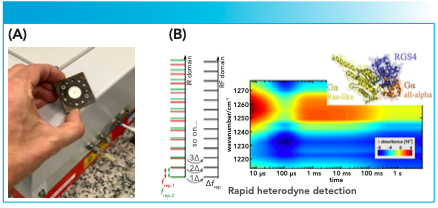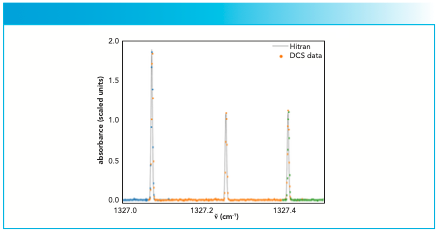Mid-Infrared QCL Dual-Comb Spectroscopy: From Non-Repetitive Protein Dynamics to Stopped-Flow Applications with Microsecond Time Resolutions
Sponsored Content
Spectroscopic reaction monitoring is a proven tool in R&D and production environments, where it is used to gain insight into chemical reaction kinetics. In this application note, we showcase how dual-comb spectroscopy (DCS) can be used to monitor protein dynamics on microsecond to second timescales. Kinetics of irreversible protein reactions require an analytical technique that provides time-dependent infrared spectra in a single shot. First results have been validated with the recording of transients of the photoactivated proton pump bacteriorhodopsin with DCS and StepScan FT-IR (1).
Non-repetitive reactions with microsecond time resolution
Fourier transform infrared spectroscopy (FT-IR) with time resolutions faster than 10 ms is only possible with proteins, where the reactions can be repeated thousands of times. Many relevant protein reactions are nonrepetitive. In many cases reactions can be induced by caged compounds (2). As an example, we investigate the inhibiting Gi protein and the larger protein–protein complex of Gαi with its cognate regulator of G-protein signaling (RGS). With DCS, we observe good data quality with 4 μs time resolution, three orders of magnitude faster than any FT-IR measurements.
Figure 1: (A) IR cuvette with photo-sensitive paper, exposed to the QC laser beam (burned point in the middle). (B) Contour-plot of the changes obtained from dual-comb spectroscopy.

Stopped-flow applications coupled with mid-IR spectroscopy—more than the sum of its parts!
Additionally, DCS can be used to monitor fast kinetic reactions in combination with the stopped-flow technique. Mid-IR stopped flow was so far limited to timescales of RapidScan FT-IR on the order of 100 ms. The combination with DCS paves the way to new research possibilities for kinetic studies in the microsecond time regime. Simply speaking, it works by rapidly mixing reagents before a spectroscopic cell, as depicted in Figure 2.
Figure 2: Scheme of stopped-flow application with in situ spectroscopy.

For these applications, we partnered with TgK Scientific and BioLogic SA. It connects via an umbilical to a spectroscopic cell with CaF2 windows and a pathlength of 100 μm.
The hydrolysis of methyl chloroacetate (MCA) is often carried out as a test for stopped flow systems and typically hydroxide concentrations of 0.1 M or less are used.

The results of a single shot of the hydrolysis reaction are shown in the Figure 3. Excellent signal to noise ratios are seen throughout the spectra and despite the low intensity of the MCA band, it can be fitted well with a monoexponential decay. A lifetime of 53 ms is found for this process at room temperature.
Figure 3: (A): Spectra of the hydrolysis reaction of MCA. 4.5 ms per spectrum. (B): resulted time traces taken at two selective wavelengths with 1000 spectra per s in situ.

High resolution dual-comb spectroscopy with QCLs
Optical frequency comb spectroscopy has further proven a very useful tool for high resolution molecular spectroscopy of gaseous samples. Frequency combs based on quantum cascade lasers (QCL) offer the possibility to easily explore the mid-infrared spectral range (4–12 μm) but suffer from very large repetition frequencies (~10 GHz) which make them seemingly unsuitable for high resolution spectroscopy.
We have developed techniques to overcome this limitation, which we call the rapid-sweep (3) and step-sweep (4) technologies. In rapid-sweep, full spectra can be measured in only 6 ms by simultaneously sweeping both frequency combs. The step-sweep technique guarantees a very accurate knowledge of the frequency axis in a record time of several min.
Both techniques have been applied to the measurement of absorption spectra of gases with narrow absorption lines at high resolution and sensitivity. The measured spectra cover a range of more than 60 cm-1 and the narrowest observed lines have a full width at half maximum of 15 MHz (0.0005 cm-1).
The broadband coverage is useful for the analysis of complex gas mixtures. The low measurement noise makes the technique the ideal tool for studying gas concentration in environmental or industrial applications (Figure 4).
Figure 4: Spectrum of methane with a spectral resolution of below 0.001 cm-1 recorded with a step-sweep technique.

References
(1) https://doi.org/10.1021/acs.analchem.8b02531.
(2) https://doi.org/10.1021/acs.analchem.1c00666.
(3) https://doi.org/10.1364/OE.379790
(4) Quantum cascade laser dual-comb spectroscopy (DCS) for methane gas mixture studies (spiedigitallibrary.org)
IRsweep AG
Laubisruetistrasse 44, 8712 Staefa, Switzerland
Tel. +41 (0)44 545 85 99
Website: www.irsweep.com
